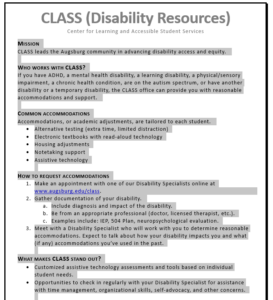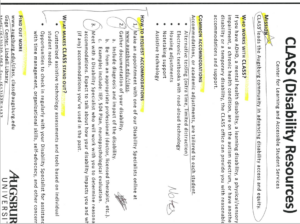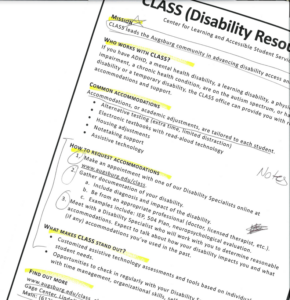TEXTBOOKS IN ALTERNATIVE FORMATS
Some students are eligible to receive alternative-format versions of their textbooks. Because of the time involved in acquiring books in alternative formats and scanning books, we ask instructors to select classroom texts as early as possible before the start of the term.
Creating and Finding Accessible Documents
Students with e-text as an accommodation may need to access accessible versions of electronic documents in order to have them available on their computer to read with their reading aloud technology, screen reading technology, or for physical access reasons. Articles for class and handouts should be posted to your course site in an accessible, electronic format. For more information on what is required to make an electronic document accessible, please review the content listed below.
Please note that the CLASS office may be in touch with you if a student reports inaccessible documents posted to your course site.
Scanned Documents
Scanned articles or scanned books are often not an accessible option for students who have e-text as an accommodation because the scans render as images instead of selectable and navigable text.
Please review your course site for any potential scanned documents, and follow the procedures featured on this site for next steps. Additionally, listed below is an example of a quality document with selectable text and an inaccessible scanned document.
Electronic document with selectable text:
Please note that the following image shows an electronic document with selectable text that will most likely read well with assistive technologies. This does not mean that all documents that you can select the text are fully accessible, but it is a good starting point and a general indicator that the document may be accessible.

Inaccessible Scanned Documents:
Please note that the following images are scanned sideways and have notes and highlights that negatively impact the accessibility of the documents. Scans like these make it challenging for students to interact and read the content.
Before scanning, please consider the following points:
- Consult your librarian for resources on where you can potentially find the online/accessible version of the book or article you are wanting to post to the course Moodle page.
- Consult your admin LFC for assistance using the Optical Character Recognition (OCR) scanning function on the campus scanners.
- Consult the CLASS Office for assistance remediating previously scanned or inaccessible documents and for consultation/resources on best practices for document accessibility.
What is Optical Character Recognition (OCR)?
OCR stands for Optical Character Recognition. OCRing a document does not make it fully accessible. However, it does significantly improve access for many students. The CLASS Office will contact you if additional remediation is needed beyond an OCR scan.
How to OCR Scan
If you must scan a document, please use a campus scanner that has a built-in OCR scanning feature.
We also have a free tool available to all faculty members called Read & Write. This program might already be on your Augsburg laptop. Check with you LFC to confirm and/or if you need assistance installing it. Once installed, you can login using your Augsburg email and use Read & Write’s virtual OCR scanner to re-scan any documents that you previously used that never received an OCR scan or any new ones that may have missed the OCR scan.
Scanning Quality
If you have determined you must scan a document or book and you plan to use the OCR feature, please note that the quality of the scan matters.
- Try not to scan pages that have notes and highlights on them.
- For primary source documents, provide transcripts as necessary.
Test the document
If you have provided a quality scan and you have used the OCR feature, please highlight the document with your cursor to ensure the OCR scanned in the correct reading order. Please note, that additional remediation and testing will be needed if a student in your course uses screen reading software. The CLASS Office will be in contact with you to assist if this is the case.
Creating Accessible Word & PowerPoint Documents
Please review the following resources improve accessibility when creating Microsoft and Google documents:
- Make your document or presentation more accessible in Google Drive
- University of Minnesota’s Instructions for how to check the accessibility of a Google Doc
Microsoft
- Add alt text on images, graphs, and charts
- Run Microsoft Word and PowerPoint’s accessibility checker
- Make your Word documents accessible to people with disabilities
- Use headings instead of just bolded content to organize documents
- Use descriptive links
- Check the reading order in PowerPoint
- Inline Images and Accessibility- University of Arkansas Division of Agriculture


